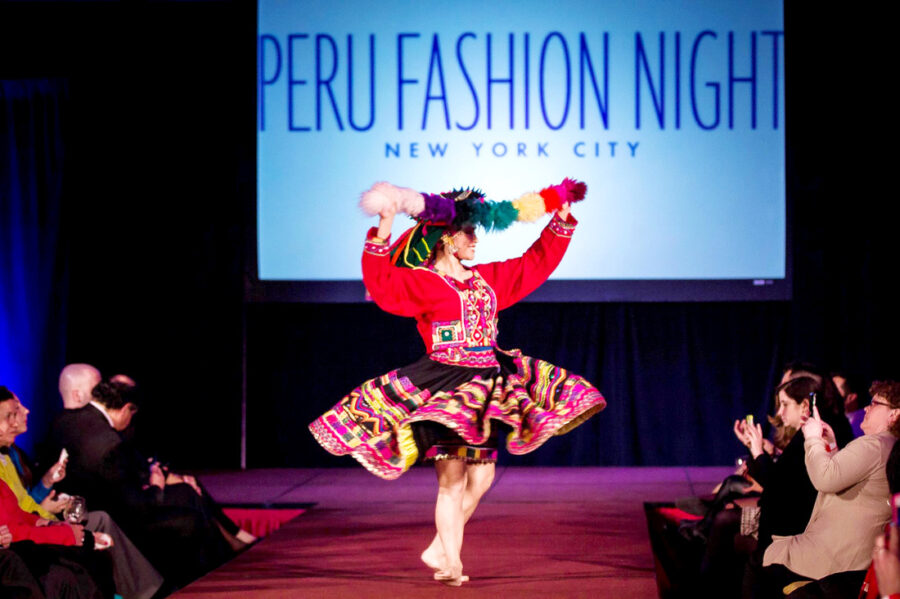Peru is a civilization where its own timeless fashion style has always served as a primary language, a living chronicle of its history, beliefs, and identity. Peruvian fashion thereby represents a continuum, stretching from millennia-old threads to contemporary avant-garde designs. This traditional textile art, developed over millennia, is an expression of a rich cultural history that dates back to pre-Columbian cultures such as Paracas and Nazca. For these societies, textiles were expressions of status, religion, and belonging.
The value placed on fabrics in pre-Columbian Peru was often comparable to that of gold and silver. This profound significance underscores that textiles served far more than a practical purpose; they were, and remain, what many describe as a “living testament to Peru’s indigenous wisdom, creative resilience, and cultural pride.” In recent years, this deep appreciation has seen a renaissance, driven by a renewed awareness of the country’s rich cultural and historical wealth, particularly its ancient clothing traditions.
The study of Peruvian textiles reveals far more than aesthetic qualities; it offers insights into a cultural archive that has preserved knowledge, belief systems, and social structures across generations. Every pattern has its own story. In a land of numerous ancient civilizations, some of which lacked widespread writing systems in the European sense, textiles functioned as a primary medium for recording history, cosmology, and spiritual beliefs. The complex patterns and symbols woven into the fabrics tell of mountains revered as deities (Apus), sacred animals, and intricate cosmological concepts. This interpretation is supported by the fact that textiles served to disseminate religious ideas and convey messages to the afterlife, as seen in ancient burial offerings, and have been described as “a philosophy constructed from visual and tactile ideas rather than verbal ones.” Their immense societal value, comparable to precious metals, underscores their central role as carriers of cultural knowledge. In this sense, Peruvian textiles are an invaluable archive of cultural memory and worldview, whose study and preservation are of crucial importance.

Woven Heritage, The Enduring Fascination of Traditional Peruvian Clothing
The sacred threads of Peruvian textiles begin with materials deeply embedded in the country’s rich biodiversity and millennia-old knowledge. Fibers such as alpaca and vicuña, native to the Andes, are prized for their softness, warmth, and durability. Vicuña wool, historically revered as the “Gold of the Andes” and once reserved for Inca royalty, today represents sustainable luxury, with traditional, respectful shearing techniques like the Chaccu experiencing a revival. Alpaca wool, also highly valued, offers hypoallergenic properties and a spectrum of natural shades. Alongside these wools, Pima cotton, particularly the Peruvian variety known as “white gold,” can look back on a heritage stretching back to approximately 3100 BCE. Cultivated primarily on the coast, it is renowned worldwide for its exceptional quality and is typically used for lighter garments.
The vibrant palette of traditional textiles is often achieved through natural dyes, a practice that underscores ancient, environmentally conscious wisdom. Weavers historically utilized a variety of plants, minerals, and insects to create deep, rich, and lasting colors. The cochineal insect, for example, found on prickly pear cacti, yields a spectrum of reds, pinks, and violets, often symbolizing blood, life, and Pachamama (Mother Earth), with Ayacucho being an important center for its use. Indigo, derived from plants like Indigofera suffruticosa, produces deep blues that can represent the sky, water, life, and power; significantly, Peru is home to the world’s oldest known indigo-dyed fabric, dating back 6,000 years. Other natural colorants include Yanali for orange hues, the lichen Qaqa Sunkha for a range of oranges, yellows, browns, and grays, and plants like Ch’illca and Mutuy for greens. This careful selection and complex processing of materials, requiring specific mordants and techniques passed down through generations, attest to sophisticated indigenous chemical knowledge and a symbiotic relationship between Peruvian cultures and their ecosystems.
These carefully chosen materials are then masterfully transformed into iconic garments, each telling its own story and varying greatly by region and community. In the Andean Highlands, women traditionally wear the Pollera, a wide, colorful, often multi-layered skirt, frequently embroidered with floral or symbolic motifs that represent their origin or community; its style can indicate social status and often fuses indigenous and Spanish colonial elements. The Lliclla (or Manta) is a rectangular shawl women wear over their shoulders for warmth or to carry children and goods. It is usually adorned with geometric or zoomorphic patterns depicting Apus, rivers, llamas, or condors, carrying deep spiritual and cultural meanings. A larger version is known as the Awayo. Men traditionally wear the Chullo, a colorful knitted cap with earflaps made from llama, vicuña, or alpaca wool, whose style, colors, and shapes can denote the wearer’s age, marital status, and village.

The Montera, a distinctive hat especially for women, varies significantly in shape and decoration, often indicating origin, such as those from Chinchero or Puno. The Poncho, an outer garment with a head opening that offers warmth and protection, originated in the 17th century for plantation workers, with its length and color varying by region; red often symbolizes power and life, while black can signify mourning or the wisdom of elders. Other notable garments include the Jobona, a women’s wool jacket; the Chumpi, a woven belt symbolizing fertility; and Ojotas, traditional sandals. Regional variations are striking: Cusco features vibrant attire; Puno reflects Aymara influence; and Ayacucho and Huancavelica are known for more subdued colors but equally detailed embroidery.
The Amazonian palette, by contrast, favors lightweight, breathable garments made from plant fibers like chambira, adorned with seeds and feathers. A central tunic-like garment, often made of cotton, is the Cushma (or Kusma). Its design varies among communities: Matsigenka men’s Cushmas have V-necks, while women have straight necks; Ashaninka men’s versions display vertical stripes, and women’s, horizontal. The Shipibo-Conibo people are famed for their complex Kené patterns, geometric designs painted or embroidered on textiles and ceramics, often inspired by Ayahuasca visions and representing life paths.
The Ashaninka also wear the Kushma, which is woven from locally grown highland cotton and dyed with natural colors. Similarly, the Yanesha have traditional Cushman and adornments called Noxrets, made from seeds and shells. The Bora are known for extensive body painting and live in communal houses called Malocas, while the Yagua traditionally wear palm fiber breastplates and skirts. Traditional coastal clothing, meanwhile, reflects a dynamic mix of indigenous, African, and European influences, with cotton being a predominant material. Across all regions, these garments are dynamic social texts, communicating identity, status, and beliefs, and continuously evolving through cultural exchange.
Visual elements in Peruvian textiles form a complex language. Colors carry deep symbolism: red can represent Pachamama, life, and power; black can signify time, authority, and wisdom; white is associated with fertility and time; blue often stands for the sky, water, or marital status; yellow evokes luck, the sun, and energy; and green symbolizes rainforests, agriculture, and hope. Pallay, or woven designs, frequently combine light and dark colors, a technique used to express the Andean concept of duality. The patterns and designs themselves, constituting a rich iconography, often represent mountains (Apus), sacred landscapes, agricultural cycles, mythical animals, deities, tribal identity, and historical events. Geometric designs frequently symbolize nature or Andean cosmology, while zoomorphic motifs depict sacred animals like condors, pumas, and snakes.
Specific motifs, such as the potato blossom indicating dependence on this vital crop, or hummingbirds symbolizing reciprocity and love, carry defined meanings. During Inca rule, coded geometric designs known as Tocapu were used, likely conveying specific information or status. Embroidery further enriches these textile narratives. Bordados Ayacuchanos (Ayacucho embroidery), with brightly colored wool, feature motifs from local flora, fauna, and Andean culture. Similarly, Bordados del Colca (Colca Valley embroidery) are known for their intricate embellishments on skirts and hats. This complex system of colors and patterns in traditional Peruvian textiles effectively functions as a “cosmogram” , a visual representation of the Andean worldview.

From Ancient Looms to Global Catwalks, The Evolution of Peruvian Fashion
The evolution of Peruvian fashion is a captivating journey from pre-Columbian mastery through colonial transformations to its dynamic presence on today’s global stage. Long before European contact, Andean and coastal civilizations had cultivated exceptionally sophisticated textile arts. The Paracas culture (c. 800 BCE-100 CE) is famed for its complex embroideries and woven textiles, notably the elaborate mummy bundles containing layers of ornate garments designed to accompany the deceased into the afterlife. The Nazca culture (c. 100-800 CE), known for its enormous geoglyphs etched into the desert plains, also produced polychrome ceramics and textiles featuring designs created through techniques like brocade, tapestry, or painting. The Moche culture (c. 100-700 CE) was highly innovative in art and technology, with their ceramics vividly documenting weaving processes and other aspects of daily life. Later, the Wari Empire (c. 500-1000 CE) left behind remarkably well-preserved textiles, including elaborate tapestries and tunics adorned with standardized motifs that suggest a degree of state control over production and design.
In the Inca Empire (c. 1430-1532 CE), textile art reached an unparalleled level of sophistication. Clothing served to distinguish royalty, nobility, and commoners, with the finest “qompi” fabrics crafted by specialized male weavers known as Qumpicamayocs. Techniques such as the discontinuous warp and weft were unique to the Andes and contributed to the complexity and beauty of their creations. Textiles expressed status, conveyed religious beliefs, and solidified identity; they were also crucial in ceremonies, used as sacred offerings, and employed as diplomatic tools. Indeed, pre-Columbian textiles were instrumental in social organization and the exercise of political power.
The arrival of the Spanish in the 16th century introduced new materials like silk, European styles such as wide skirts and lace blouses, and different embroidery techniques. Indigenous Peruvians often had to adapt to these changes, leading to a unique cultural fusion. One manifestation of this was indigenous women layering colorful Polleras under planer Spanish skirts. Clothing also became an instrument of social control, with Spanish authorities issuing sumptuary laws (Leyes Suntuarias) that prohibited non-Spanish groups from wearing certain luxurious items. Casta paintings, a genre of colonial art, often visualized this social hierarchy through depictions of clothing. Despite these restrictions, the indigenous population adapted, using the inherent fluidity of clothing to navigate the imposed colonial system. This intermingling of traditions gave rise to the Mestizo style, reflecting a vibrant blend of European and indigenous aesthetics that continues to shape Peruvian identity today.

The New Weave, Contemporary Peruvian Fashion on the World Stage
Today’s Peruvian fashion scene dynamically reinterprets its rich textile heritage, gaining international acclaim for its synthesis of ancient techniques, noble natural fibers, and modern, often sustainable, approaches. A new generation of designers is bringing this legacy to global catwalks, championing both innovation and tradition. Several designers are at the forefront of redefining Peruvian tradition for a modern audience. Meche Correa is an internationally recognized figure whose work is deeply rooted in Peruvian history and folk art, skillfully integrating traditional themes into contemporary designs. She frequently collaborates with artisans, emphasizing sustainable luxury and cultural preservation. “Peru must be loved to rediscover it and give it the place in the world it deserves,” Correa has stated, encapsulating her mission.
Annaiss Yucra (A.Y.), celebrated by publications like Vogue, masterfully blends fashion with art and social activism. Her collections, bearing names such as “Revolución,” “Matriarcado,” and “Pachamama,” reflect her commitment to conveying the multifaceted narratives of Peru through her designs. Yucra collaborates with communities for natural dyeing and weaving and was the first Latin American brand to debut in the Metaverse. The ethical luxury brand ESCVDO, founded by sisters Chiara and Giuliana Macchiavello, is dedicated to preserving Peruvian textile traditions through a modern lens and strong ethical principles, working with over 300 artisan families. Their collections draw inspiration from Peru’s diverse landscapes and cultures.
Jorge Luis Salinas, often dubbed the “Pride of Gamarra” (a large textile market in Lima), is known for integrating Andean ponchos and alpaca textiles into his work. His Fall 2024 “HUAYLARSH” collection, inspired by the traditional dances of Junín, featured luxurious alpaca wool and intricate embroideries at Milan Fashion Week. Other notable designers contributing to this vibrant landscape include Ana G. (Ana Guiulfo), Kero (Mariella Gonzales), SAKE (Ana Tafur), and Le Qara, an eco-fashion brand pioneering the use of fruit and plant-based leather. Many contemporary Peruvian designers, especially those of the younger generation, consciously merge fashion with social and cultural activism, empowering marginalized communities and advocating for sustainability.

Crucial for promoting national talent and materials are Peru Moda, an annual national trade show, and Lima Fashion Week (LIF Week). Peru Moda showcases the country’s prized alpaca wool and Pima cotton, alongside the intricate work of its artisans, with a strong focus on sustainable fashion. It connects Peruvian exporters with international buyers and features the “Young Creators to the World” runway, fostering new talent. Since its inception in 2011, Lima Fashion Week has become a key platform for national designers, presenting innovative proposals and uniting both established and emerging names. Both events consistently emphasize Peru’s flagship materials and promote ethical, sustainable, and inclusive fashion. They often highlight collaborations with indigenous artisans, transforming traditional garments into contemporary styles fit for a global audience. These platforms are strategic components of Peru’s national branding and economic development, positioning the country as a hub for high-quality, culturally unique fashion.
The rise of ethical Peruvian fashion and collaborations with artisans increasingly shapes the country’s presence in the global industry, positioning Peru as a leader in the “slow fashion” movement. Sustainable practices, the use of unique natural fibers, and ethical partnerships with artisan communities are central to this identity. Alpaca, often referred to as the “Gold of the Andes,” and organic Pima cotton are cornerstones of this approach. Vicuña wool, one of the finest and rarest fibers in the world, offers unparalleled luxury combined with sustainable harvesting traditions passed down through generations. Designers are increasingly collaborating directly with artisan communities, ensuring the preservation of heritage techniques and fair wages. These sustainable practices also include reviving natural dyeing methods, promoting ethical shearing, and implementing zero-waste design principles, reflecting a holistic commitment to environmental and social responsibility.
The Fabric of a Nation, Enduring Influences and Future Threads
Peruvian fashion intrinsically mirrors the country’s soul, profoundly shaped by its diverse geography, dynamic climate, and layered history. This interplay has created a textile tradition that is both ancient and remarkably contemporary. The influence of geography and climate is evident in the very materials and forms of Peruvian attire. The cold Andean highlands necessitate warm garments like ponchos and chullos, typically crafted from insulating alpaca wool. Conversely, the hot, humid Amazon basin favors lightweight, breathable clothing made from plant fibers, such as the Cushma. Coastal regions, with their more temperate conditions, have historically utilized the versatility of cotton. History, too, has woven its indelible mark. Pre-Columbian heritage established extraordinarily advanced textile traditions that formed the bedrock of Peruvian material culture.
Colonial influence subsequently introduced new materials and styles, leading to distinctive fusions that are still visible today. Modernity and globalization now bring both challenges and opportunities, fostering a renewed appreciation for authenticity and traditional craftsmanship. Fundamentally, Peruvian fashion is a continuous dialogue with its diverse environments, evident in the choice of materials, the functionality of garments, and the symbolic integration of nature into its designs. This sartorial soul continues to find vibrant cultural expression and achieve growing global resonance.
Traditional clothing remains a powerful emblem, a “living testament to indigenous wisdom, creative resilience, and cultural pride.” Simultaneously, Peruvian designers are gaining increasing international recognition, showcasing their unique vision at major fashion weeks in Paris, Milan, and New York. The global demand for handwoven alpaca products and other unique Peruvian materials is steadily rising, driven by a desire for quality, authenticity, and sustainable practices. However, this global spotlight also presents challenges. Globalization can bring import competition that affects local artisans, and there is an ever-present risk of cultural appropriation if traditions are used without proper credit, understanding, or benefit to the origin cultures. Addressing this involves fostering direct purchasing relationships with artisans, promoting fair trade principles, and educating consumers to reject imitations and support authentic craftsmanship.
The Thread of the Future
The evolution of Peruvian fashion from its rich indigenous roots through periods of colonial fusion to its contemporary resurgence as a symbol of national identity and a significant player in sustainable luxury presents a compelling narrative of a postcolonial nation reclaiming and revaluing its cultural heritage. Contemporary designers are not merely referencing the past; they are consciously drawing upon ancestral techniques and philosophies, infusing them with modern sensibilities. National efforts actively promote Peru on the world stage based on these unique textile values and commitment to cultural integrity. The pronounced emphasis on sustainability aligns powerfully with modern global values, yet it often draws from long-standing indigenous principles of respect for nature and communal well-being.
Ultimately, Peruvian fashion is about more than just aesthetics; it is deeply intertwined with identity, economic sovereignty, and the ongoing negotiation of cultural meaning in a globalized world. Its future success will depend on skillfully balancing the demands of the global market with the imperative to preserve authenticity and equitably empower its traditional bearers. The thread of Peruvian fashion, spun from millennia of history and woven with enduring resilience, holds the potent potential to continue inspiring the world with its beauty, depth, and unwavering ethical compass.
#Peru #PeruvianFashion #PeruvianTextiles #Alpaca #PimaCotton #SustainableFashion #EthicalFashion #IndigenousCulture #AndeanDesign #AmazonTextiles #LimaFashionWeek #PeruModa #CulturalHeritage #SlowFashion #MadeInPeru #SustainableLuxury #ArtisanMade









